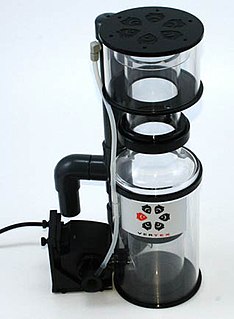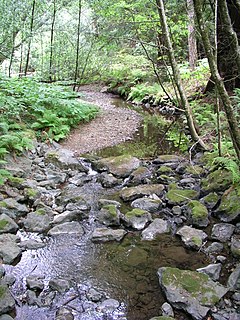
Eutrophication, or hypertrophication, is when a body of water becomes overly enriched with minerals and nutrients which induce excessive growth of algae. This process may result in oxygen depletion of the water body. One example is an "algal bloom" or great increase of phytoplankton in a sandy body as a response to decreased levels of nutrients. Eutrophication is often induced by the discharge of nitrate or phosphate-containing detergents, fertilizers, or sewage into an aquatic system.

Surfactants are compounds that lower the surface tension between two liquids, between a gas and a liquid, or between a liquid and a solid. Surfactants may act as detergents, wetting agents, emulsifiers, foaming agents, and dispersants.

Water pollution is the contamination of water bodies, usually as a result of human activities. Water bodies include for example lakes, rivers, oceans, aquifers and groundwater. Water pollution results when contaminants are introduced into the natural environment. For example, releasing inadequately treated wastewater into natural water bodies can lead to degradation of aquatic ecosystems. In turn, this can lead to public health problems for people living downstream. They may use the same polluted river water for drinking or bathing or irrigation. Water pollution is the leading worldwide cause of death and disease, e.g. due to water-borne diseases.

A protein skimmer or foam fractionator is a device used to remove organic compounds such as food and waste particles from water. It is most commonly used in commercial applications like municipal water treatment facilities and public aquariums. Smaller protein skimmers are also used for filtration of home saltwater aquariums.

A constructed wetland (CW) is an artificial wetland to treat municipal or industrial wastewater, greywater or stormwater runoff. It may also be designed for land reclamation after mining, or as a mitigation step for natural areas lost to land development.

De-icing is the process of removing snow, ice or frost from a surface. Anti-icing is understood to be the application of chemicals that not only de-ice but also remain on a surface and continue to delay the reformation of ice for a certain period of time, or prevent adhesion of ice to make mechanical removal easier.

An aquatic ecosystem is an ecosystem in a body of water. Communities of organisms that are dependent on each other and on their environment live in aquatic ecosystems. The two main types of aquatic ecosystems are marine ecosystems and freshwater ecosystems.

In biology, detritus is dead particulate organic material, as distinguished from dissolved organic material. Detritus typically includes the bodies or fragments of bodies of dead organisms, and fecal material. Detritus typically hosts communities of microorganisms that colonize and decompose, i. e., remineralize, it. In terrestrial ecosystems it is present as leaf litter and other organic matter that is intermixed with soil, which is denominated "soil organic matter". The detritus of aquatic ecosystems is organic material that is suspended in the water and accumulates in depositions on the floor of the body of water; when this floor is a seabed, such a deposition is denominated "marine snow".

Indian ice cream, also known as Sxusem, is a Canadian whipped confection made from soapberries and other various fruits, these have been eaten as a traditional dessert by many First Nations peoples. It has been suggested that it was first produced in the Interior Salish territory of British Columbia which was located in the upper basins of the Columbia and Fraser rivers, and included tribes such as the Columbia, Lillooet, Shuswap among others.
Lithotrophs are a diverse group of organisms using inorganic substrate to obtain reducing equivalents for use in biosynthesis or energy conservation via aerobic or anaerobic respiration. Known chemolithotrophs are exclusively microorganisms; no known macrofauna possesses the ability to use inorganic compounds as energy sources. Macrofauna and lithotrophs can form symbiotic relationships, in which case the lithotrophs are called "prokaryotic symbionts". An example of this is chemolithotrophic bacteria in giant tube worms or plastids, which are organelles within plant cells that may have evolved from photolithotrophic cyanobacteria-like organisms. Lithotrophs belong to the domains Bacteria and Archaea. The term "lithotroph" was created from the Greek terms 'lithos' (rock) and 'troph' (consumer), meaning "eaters of rock". Many but not all lithoautotrophs are extremophiles.

Water aeration is the process of increasing or maintaining the oxygen saturation of water in both natural and artificial environments.

Nonpoint source (NPS) pollution is pollution resulting from many diffuse sources, in direct contrast to point source pollution which results from a single source. Nonpoint source pollution generally results from land runoff, precipitation, atmospheric deposition, drainage, seepage, or hydrological modification where tracing pollution back to a single source is difficult.

River ecosystems are flowing waters that drain the landscape, and include the biotic (living) interactions amongst plants, animals and micro-organisms, as well as abiotic (nonliving) physical and chemical interactions of its many parts. River ecosystems are part of larger watershed networks or catchments, where smaller headwater streams drain into mid-size streams, which progressively drain into larger river networks.
Dissolved organic carbon (DOC) is the fraction of total organic carbon operationally defined as that which can pass through a filter size that typically ranges in size from 0.22 and 0.7 micrometers. The fraction remaining on the filter is called particulate organic carbon (POC).

Secondary treatment is a treatment process for wastewater to achieve a certain degree of effluent quality by using a sewage treatment plant with physical phase separation to remove settleable solids and a biological process to remove dissolved and suspended organic compounds. After this kind of treatment, the wastewater may be called as secondary-treated wastewater.

The phosphorus cycle is the biogeochemical cycle that describes the movement of phosphorus through the lithosphere, hydrosphere, and biosphere. Unlike many other biogeochemical cycles, the atmosphere does not play a significant role in the movement of phosphorus, because phosphorus and phosphorus-based compounds are usually solids at the typical ranges of temperature and pressure found on Earth. The production of phosphine gas occurs in only specialized, local conditions. Therefore, the phosphorus cycle should be viewed from whole Earth system and then specifically focused on the cycle in terrestrial and aquatic systems.

A trickling filter is a type of wastewater treatment system. It consists of a fixed bed of rocks, coke, gravel, slag, polyurethane foam, sphagnum peat moss, ceramic, or plastic media over which sewage or other wastewater flows downward and causes a layer of microbial slime (biofilm) to grow, covering the bed of media. Aerobic conditions are maintained by splashing, diffusion, and either by forced-air flowing through the bed or natural convection of air if the filter medium is porous.
Freshwater environmental quality parameters are the natural and man-made chemical, biological and microbiological characteristics of rivers, lakes and ground-waters, the ways they are measured and the ways that they change. The values or concentrations attributed to such parameters can be used to describe the pollution status of an environment, its biotic status or to predict the likelihood or otherwise of a particular organisms being present. Monitoring of environmental quality parameters is a key activity in managing the environment, restoring polluted environments and anticipating the effects of man-made changes on the environment.

Sea foam, ocean foam, beach foam, or spume is a type of foam created by the agitation of seawater, particularly when it contains higher concentrations of dissolved organic matter derived from sources such as the offshore breakdown of algal blooms. These compounds can act as surfactants or foaming agents. As the seawater is churned by breaking waves in the surf zone adjacent to the shore, the surfactants under these turbulent conditions trap air, forming persistent bubbles that stick to each other through surface tension. Sea foam is a global phenomenon and it varies depending on location and the potential influence of the surrounding marine, freshwater, and/or terrestrial environments. Due to its low density and persistence, foam can be blown by strong on-shore winds from the beach face inland.
Continuous foam separation is a chemical process closely related to foam fractionation in which foam is used to separate components of a solution when they differ in surface activity. In any solution, surface active components tend to adsorb to gas-liquid interfaces while surface inactive components stay within the bulk solution. When a solution is foamed, the most surface active components collect in the foam and the foam can be easily extracted. This process is commonly used in large-scale projects such as water waste treatment due to a continuous gas flow in the solution.



















